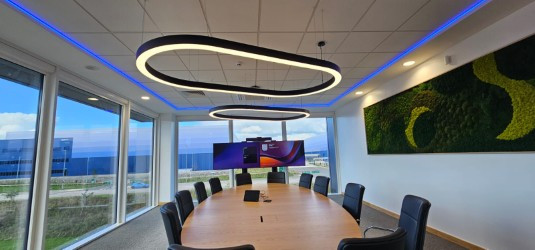Revolutionising construction - the power of laser cleaning
In recent years, technological advancements have brought about transformative changes in various industries and the construction sector is no exception. One such innovation that has gained momentum is laser cleaning, with its ability to remove unwanted substances from surfaces efficiently and effectively – a development that is revolutionising the construction industry, writes John Ridgeway.
Laser cleaning technology has been in existence for several decades. The concept of using lasers for cleaning surfaces was developed in the 1960s, and since then, significant advancements have been made in the technology. However, widespread adoption in various industries, including construction, has occurred more prominently in recent years as the technology has become more refined and accessible.
Laser cleaning is a non-contact, environmentally friendly surface cleaning process that utilises laser beams to remove contaminants, coatings, rust, and other unwanted materials from surfaces. Unlike traditional cleaning methods such as abrasive blasting or chemical cleaning, laser cleaning does not involve the use of harsh chemicals or abrasive materials, making it safer and more sustainable.
The process involves directing a focused laser beam onto the surface to be cleaned. When the laser beam interacts with the contaminants or coatings on the surface, it vaporises or ablates them, leaving behind a clean surface. The intensity and duration of the laser pulse can be adjusted to suit the specific cleaning requirements, allowing for precise and controlled cleaning without damaging the underlying substrate.
Laser cleaning technology offers a wide range of applications in the construction industry, making it a versatile tool for various tasks such as removing rust and corrosion, especially in structures exposed to harsh environmental conditions, restoring them to their original condition and prolonging their lifespan.
Surface preparation is a critical step in construction projects, as it ensures proper adhesion of coatings, paints, and sealants. Laser cleaning provides a precise and thorough method for removing contaminants and preparing surfaces for subsequent treatments.
Graffiti vandalism is another persistent issue, especially in urban areas requiring frequent cleaning and maintenance, where laser cleaning offers a rapid and efficient solution. The process ensures that graffiti can be removed from various surfaces, including concrete, brick, and metal, without causing damage to the underlying substrate.
Likewise, concrete surfaces, that can accumulate dirt, stains, and other contaminants over time, detracting from their appearance and durability. Laser cleaning can effectively remove surface contaminants from concrete, restoring its aesthetic appeal and structural integrity.
Laser cleaning technology is also being used for historic preservation projects, where delicate or intricate surfaces require gentle cleaning methods. By selectively removing layers of dirt, grime, and pollutants, laser cleaning can reveal the original beauty of historic structures without causing damage.
The adoption of laser cleaning technology in the construction industry offers numerous benefits. Laser cleaning is a chemical-free and environmentally friendly cleaning method that eliminates the need for hazardous chemicals and abrasive materials, reducing environmental impact.
Laser cleaning also allows for precise and controlled cleaning, enabling operators to target specific areas and adjust cleaning parameters as needed, resulting in consistent and high-quality results.
While the initial investment in laser cleaning equipment may be higher than traditional cleaning methods, the long-term cost savings associated with reduced material consumption, labour, and downtime make it a cost-effective solution.
Laser cleaning also eliminates the health and safety risks associated with abrasive blasting and chemical cleaning, providing a safer working environment for construction workers and operators.
The technology is highly versatile and can be used on a wide range of surfaces, materials, and contaminants, making it suitable for diverse applications in the construction industry.
In Europe, laser cleaning technology has already been used extensively for the restoration of historic buildings and monuments. By carefully removing layers of dirt, grime, and pollutants, laser cleaning has helped preserve the architectural heritage of centuries-old structures.
Laser cleaning is also being used for the maintenance and upkeep of bridges and infrastructure. By removing rust, corrosion, and surface contaminants from metal surfaces, laser cleaning helps extend the lifespan of bridges and ensures their structural integrity.
Cities around the world are also turning to laser cleaning technology to combat graffiti vandalism. By quickly and effectively removing graffiti from public spaces, laser cleaning helps keep urban areas clean and attractive, enhancing quality of life for residents and visitors alike.
So we can see that laser cleaning technology is transforming the construction industry by offering a safer, more efficient, and environmentally friendly alternative to traditional cleaning methods. With its versatility, precision, and cost-effectiveness, laser cleaning has become an indispensable tool for a wide range of applications in construction, from rust removal and surface preparation to graffiti removal and historic preservation. As the construction industry continues to embrace innovation, the technology is poised to play a central role in shaping the future of construction practices and standards.
Sources of information
https://www.nomadlasercleaning.com/
https://www.buildingconservation.com/articles/laser/laser.htm
Additional Blogs

Utilities consultants: providing the vital support every construction project needs
The UK’s cost of living crisis is adding significant financial challenges for everyone across the built environment, not least property developers and builders. While utilities consultants can’t do...
Read moreWhy cutting down trees will not solve the UK’s subsidence crisis
Across the UK, thousands of healthy, mature trees are being cut down each year in the name of protecting homes from subsidence. The issue is especially acute in the clay areas of southern England,...
Read more

The changing face of workplace AV and what FM managers need to know
In today’s hybrid workplaces, facilities managers can no longer treat audio-visual systems as background infrastructure - they are now mission-critical assets that directly influence productivity,...
Read more